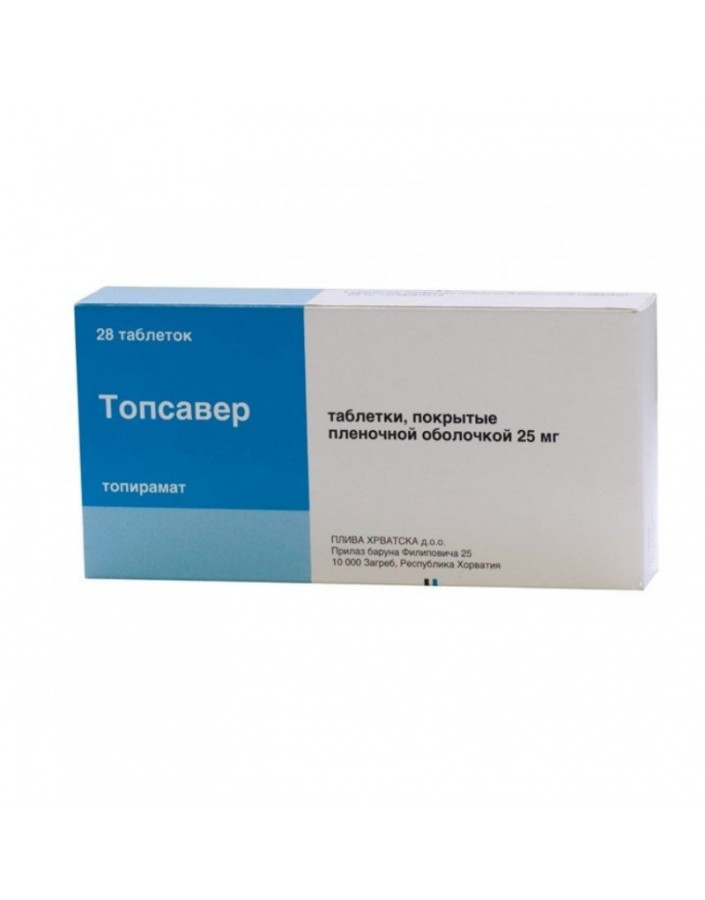




Security policy (edit with Customer reassurance module)

Delivery policy (edit with Customer reassurance module)

Return policy (edit with Customer reassurance module)
Film Coated Tablets
1 tab. contains topiramate 100 mg;
Excipients: lactose monohydrate, pregelatinized starch, partially pregelatinized starch, MCC, sodium carboxymethyl starch, Magnesium stearate;
shell: hypromellose, polysorbate 80, talc, titanium dioxide (E171)
28 pcs.
Topsaver has antiepileptic effect.
Contraindications
Carefully: renal or hepatic failure, nephroluritiasis (including in own or family history), hypercalciuria.
Topsaver taken orally, swallowing the pill whole, without chewing, regardless of the meal.For optimal control of seizures, it is recommended to start treatment with low doses followed by an increase to the effective dose.
For adults: The minimum effective dose is 200 mg / day. The usual daily dose is 200-400 mg (for 2 doses). The maximum daily dose is 1600 mg. Treatment begins with 25-50 mg daily overnight for 1 week. Then the dose is increased by 25-50 mg per day for 1-2 weeks, with a frequency of 2 times a day. In case of intolerance to such a dosing regimen, the dose is increased by a smaller amount or at longer intervals. Dose and frequency of administration are selected depending on the clinical effect.
Children older than 3 years: The recommended daily intake is 5–9 mg / kg, divided into 2 doses. Treatment begins with a dose of 25 mg at night for 1 week. Then the dose is increased by 1–3 mg / kg / day for 1–2 weeks, with a frequency of 2 times a day, until the optimum clinical effect is achieved.
From the nervous system and sensory organs: hyperexcitability, dizziness, headache, speech and vision impairment, psychomotor retardation, ataxia, fatigue, difficulty concentrating, confusion, paresthesia, drowsiness, thinking disorder, diplopia, anorexia, nystagmus, depression, taste perversion, agitation, cognitive disorders, emotional lability, apathy, psychotic symptoms, aggressive behavior, suicidal ideas or attempts; additionally in children - personality disorders, increased salivation, hyperkinesia, hallucinations.
On the part of the gastrointestinal tract: dyspeptic symptoms, nausea, abdominal pain, diarrhea, dry lips, increased activity of hepatic transaminases, hepatitis, hepatic insufficiency.
From the organs of vision: Myopia syndrome may occur on the background of increased intraocular pressure with a sharp decrease in visual acuity and pain in the eye area. Myopia, a decrease in the depth of the anterior chamber of the eye, hyperemia of the mucous membrane of the eye and increased intraocular pressure, mydriasis. A possible mechanism of these disorders is an increase in the supraciliary effusion, which leads to the displacement of the lens and iris and, as a result, the development of secondary angle-closure glaucoma.
From the skin and mucous membranes: erythema multiforme, pemphigus, Stevens-Johnson syndrome, and toxic epidermal necrolysis.
Other: weight loss, leukopenia, nephrolithiasis, oligohydrosis (mainly in children), metabolic acidosis.
Patients with a predisposition to nephrolourithiasis increase the risk of kidney stones, for which prevention requires an adequate increase in fluid intake. During the period of treatment, care must be taken when driving and engaging in other potentially hazardous activities that require increased concentration and psychomotor reactions.
Reduces the effectiveness of oral estrogen-containing contraceptives.Decreases Digoxin AUC by 12%. Concurrent use of ethanol or other drugs that depress the central nervous system is not recommended. When taken simultaneously with Carbamazepine, the AUC of carbamazepine remains unchanged or changes slightly (less than 10%), while the AUC of topiramate is reduced by 40%. With co-administration of the AUC, phenytoin remains unchanged or increases by 25%, while the AUC of topiramate decreases by 48%; may require correction dosing regimen of the latter. With simultaneous use with valproic acid AUC, valproic acid is reduced by 11%, topiramate - by 14%. Carbonic anhydrase inhibitors (acetazolamide) increase the risk of formation of kidney stones.
Symptoms: convulsions, impaired consciousness up to coma, decreased blood pressure, severe metabolic acidosis, increased severity of side effects.
Treatment: gastric lavage, Activated carbon intake, symptomatic therapy, hemodialysis.
In the dark place at a temperature of no higher than 25 ° C.
Topsaver